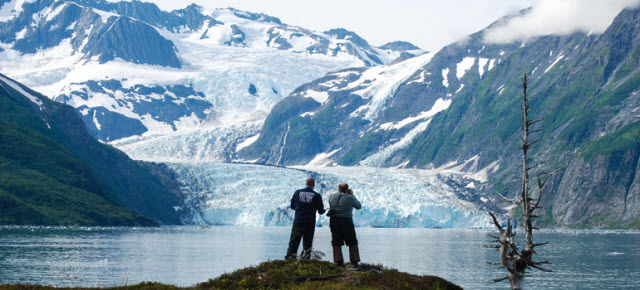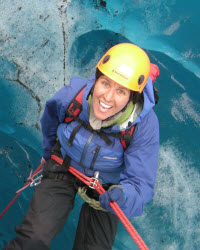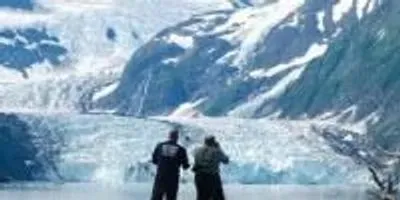 The Surprise Glacier in Alaska.Photo Credit: U.S. Geological Survey/FlickrClimate change is causing more than just warmer oceans and erratic weather. According to scientists, it also has the capacity to alter the shape of the planet.
The Surprise Glacier in Alaska.Photo Credit: U.S. Geological Survey/FlickrClimate change is causing more than just warmer oceans and erratic weather. According to scientists, it also has the capacity to alter the shape of the planet.
In a five-year study published Oct. 1 in Nature, lead author Michele Koppes, assistant professor in the Department of Geography at the University of British Columbia, compared glaciers in Patagonia and in the Antarctic Peninsula. She and her team found that glaciers in warmer Patagonia moved faster and caused more erosion than those in Antarctica, as warmer temperatures and melting ice helped lubricate the bed of the glaciers.
 Michele Koppes in Alaska.Photo courtesy of the University of British Columbia“We found that glaciers erode 100 to 1,000 times faster in Patagonia than they do in Antarctica,” said Koppes. “Antarctica is warming up, and as it moves to temperatures above 0 degrees Celsius, the glaciers are all going to start moving faster. We are already seeing that the ice sheets are starting to move faster and should become more erosive, digging deeper valleys and shedding more sediment into the oceans.”
Michele Koppes in Alaska.Photo courtesy of the University of British Columbia“We found that glaciers erode 100 to 1,000 times faster in Patagonia than they do in Antarctica,” said Koppes. “Antarctica is warming up, and as it moves to temperatures above 0 degrees Celsius, the glaciers are all going to start moving faster. We are already seeing that the ice sheets are starting to move faster and should become more erosive, digging deeper valleys and shedding more sediment into the oceans.”
Related article: Study: Melting Glaciers Have Big Carbon Impact
The repercussions of this erosion add to the already complex effects of climate change in the polar regions. Faster moving glaciers deposit more sediment in downstream basins and on the continental shelves, potentially impacting fisheries, dams and access to clean freshwater in mountain communities. “The polar continental margins in particular are hotspots of biodiversity,” notes Koppes. “If you’re pumping out that much more sediment into the water, you’re changing the aquatic habitat.”
The Canadian Arctic, one of the most rapidly warming regions of the world, will feel these effects acutely. With more than four degrees Celsius of warming over the last 50 years, the glaciers are on the brink of a major shift that will see them flowing up to 100 times faster if the climate shifts above zero degrees Celsius.
The findings by Koppes and coauthors also settle a scientific debate about when glaciers have the greatest impact on shaping landscapes and creating relief, suggesting that they do the most erosive work near the end of each cycle of glaciation, rather than at the peak of ice cover. The last major glacial cycles in the Vancouver region ended approximately 12,500 years ago.
The study, Observed latitudinal variations in erosion as a function of glacier dynamics, appears in Nature.
Climate change is causing more than just warmer oceans and erratic weather. According to scientists, it also has the capacity to alter the shape of the planet.
To continue reading this article, sign up for FREE to

Membership is FREE and provides you with instant access to eNewsletters, digital publications, article archives, and more.


